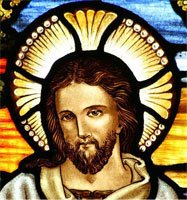Christianity

Christianity began as a sect of Judaism in the
Mediterranean Basin of the 1st century CE and evolved into a separate religion - the
Christian Church. Jesus is the central figure of Christianity, considered by almost all denominations to
be divine, typically as one person of a Triune God. The
Christian Bible is held to be the ultimate authority, alongside Sacred Tradition in some denominations, such as
Roman Catholicism and Eastern Orthodoxy.
Christianity is divided into three main
branches: Catholic, Orthodox and Prosestant Spirit. The Catholic Church considers itself the one true Church. It does not
consider any groups or denominations to be true “churches” unless they have maintained apostolic succession
and observe the seven sacraments (the Eastern Orthodox Church
is the only other true “church”.)
Denominations of Protestantism include:
Lutheranism, Anglicanism, Presbyterianism, Congregationalist Churches, Anabaptists, Brethren, Methodists, Baptists,
Apostolic Churches, Pentecostalism, Religious Society of Friends (Quakers).
Groups that avoid a formal denominational
structure include the Restoration Movement.
For Christians, the Bible has two
components:
1) Old Testament
2) New Testament
Testament is also known as Covenant, which an
agreement or a contract. Christians believe that the promises of the Old Covenant were completely fulfilled
in the life of Jesus Christ and that Jesus transformed its terms so that a New Covenant was instituted.
Judaism and Christianity are absolutely divided on the issue of whether God’s promises were fulfilled.
Christians accept the Old Testament, but it is interpreted in terms of the New Testament. The New Testament was
written by fewer authors than the Old Testament and was written between approximately 50-150 AD.
After the death of Jesus, his followers held
meetings in a building that later became known as a "church," a word derived from the Greek kuriakon, meaning "the
Lord's house." The church’s mission was to spread Jesus’s message. To assure that Jesus’s message was
correctly preserved, taught and inspirational, the Church created the writings known as the New Testament (all the
books were originally written Greek). The New Testament contains 27 books divided into 4
sections:
1) Gospels
The word gospel is
derived from the Anglo-Saxon word ‘godspell’, meaning "good news." Four of Jesus’s closest followers,
Matthew, Mark, Luke and John, wrote testimonies of their belief about him and of the proclamation of good news.
Although appearing second in order, the book of Mark was the first, and shortest, Gospel written. Biblical
scholars believe that Matthew and Luke used Mark, as well as other sources, to write their Gospels since many of
their passages are similar to Mark (the synoptic Gospels). The Gospel of John contains much less information
found in the Synoptics and probably drew on traditions about Jesus that were unknown to the other
Gospels.
2) Acts of the Apostles
The book
called the Acts tells of the founding of the Church and the early work of the apostles. The Acts consists of
two sections: 1) "acts of Peter", 2) "acts of Paul". Peter was one of Jesus' original disciples and later
became the first of the apostles. Paul was the missionary to the non-Jewish world of the Roman Empire.
Peter and Paul were executed by Roman authorities which marked the closed the early period of the
church.
3) Epistles
(letters)
Many of the 21 books called the Epistle were
written by St. Paul. The names of his epistles are Romans, I and II Corinthians, Galatians, Ephesians, Philippians,
Colossians, I and II Thessalonians, I and II Timothy, Titus, and Philemon. The letters were meant to be read
aloud in Church and their message contained interpretations of the Gospel, solutions to local problems and advice
how Christians were to live. The Letter to the Hebrews was a letter to Christians of Jewish background that
used Old Testament material to demonstrate that the ministry of Jesus Christ was the fulfillment of the Old
Covenant. Other epistles are James (I, II), Peter (I, II, III), John, and Jude. They are referred to as the
Catholic Epistles, meaning that they meant for general circulation. The purpose of the letters was to give guidance
for everyday living, refute false doctrine, and encourage perseverance in the face of opposition and
persecution.
4)
Revelation
The Book of Revelation is the apocalyptic story
of the end of the world and the triumph of the Kingdom of God (also known as the Apocalypse of St. John the
Divine). Although imaginative, it is very difficult to interpret (some say it’s John's psychotic dream). The
theme of Revelation uses the lordship of God over history, a message intended to encourage Christians to endure
savage persecutions, because the Kingdom of God is near.
z
| 